Forms
Forms list
Select menu Design/Form to display forms list view.
Add a new form
To create a new form, click on the 'Add' button.
Import forms
To import forms, click on import button, and select an import file.
Export forms
To export forms, select the forms you wish to export in the form list view, click the export button, name the export file.
Delete forms
Select form to delete and click on Delete button.
Edit a form
To edit a form, click on hit name on the form list view.
Forms and data structure
Every form will maintain a JSON data structure that contain the user data entry.
Form designer

Main tabs: Form designer / Test context / Information
Form Designer tab: Let you design your form.
Test context tab: Let you define test data.
Information tab: Let you define form name and other details.
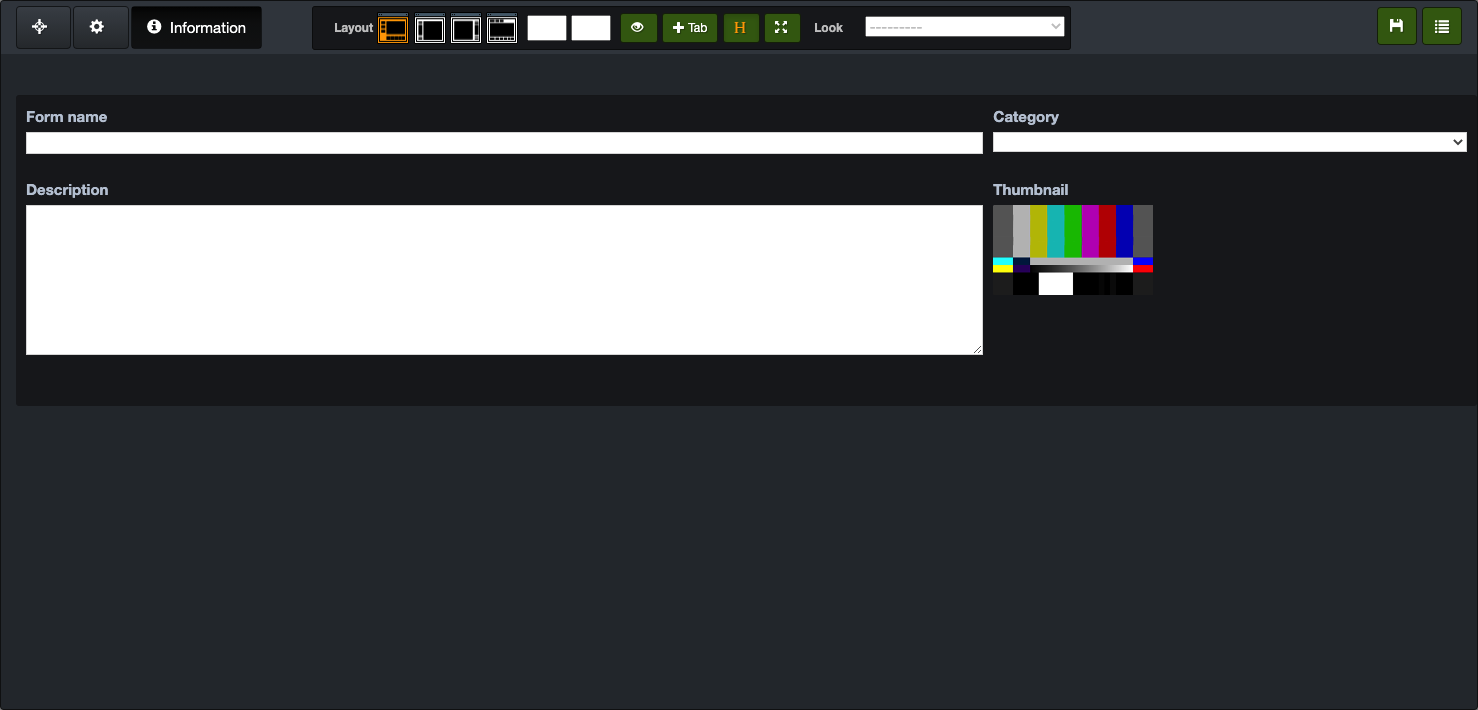
Form name
Defines the name of the form. This name will be used by Sequence jobs to address specific forms.
Category
Description
Thumbnail
Tabs
Forms let you define as many tabs as necessary. Tabs are used to divide you form in several piece to make it clearer. It may be also used to group JSON data generated by the form.
Layout (Tabs / buttons position)

Let you organize where to display tabs and button.
Adding a tab
Press the +Tab button a add a tab.
Editing a tab
Double-click on a tab to edit it. Tab parameters dialog will popup.
Tab edition Main tab

Header
Let you browse and choose a file to be used as a banner. You may also set the background color of this area.
Look (CSS)
Let you define which Theme (CSS) will be used to display your form. Themes can be defined in the menu Design/CSS.
Forms objects
Adding a new form object
Select the object you need in the right list and drag it to the design pane. A specific dialog will pop-up to allow you to set the object parameters.
Resizing a form object
You can resize the object itself or the object container. Move your mouse to right side of the object.
If you see an orange vertical bar, you will resize the object container.
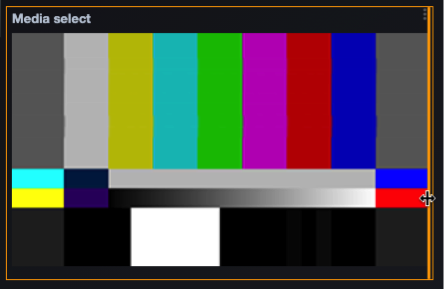
If you see a green vertical bar, you will resize the object inside the object container.
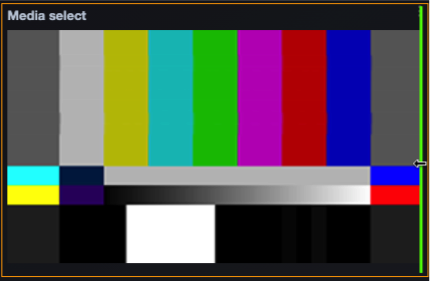
Editing a form object
To edit a form object you can double-click on the object.
Shortcuts
Move your mouse close to the upper right corner, you will see a small object.
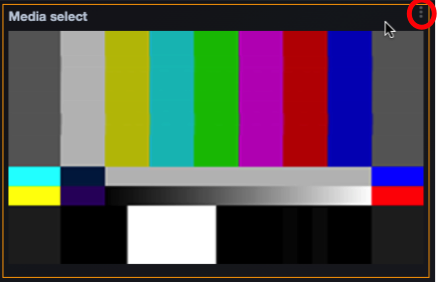
and If your mouse gets closer, you'll display a list of actions.
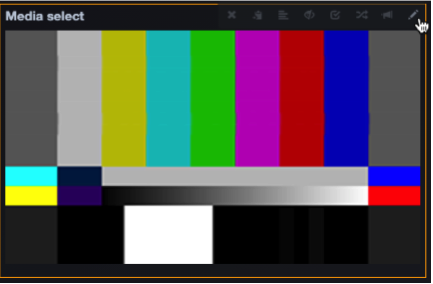
From left to right you will find:
Remove object
This will delete the form object. If you delete an object by error, select menu "Cancel" to retrieve your object.
Copy field path
Put in your clipboard the path to the form object that can be used in JS callbacks with function Find_editor.
Alignement
Allow you to change alignment.
Hide title
Show/hide the object title.
Mandatory
Set the field as mandatory
Conditions
Define object "Conditions"
Callbacks
Open Callback dialog.
Edit
Open the edit dialog for this form object.
Conditions and Callbacks
What is a field condition
Field conditions are a way to change field state, css or value by testing evaluation of a statement (the condition). If result is true, corresponding action is executed.
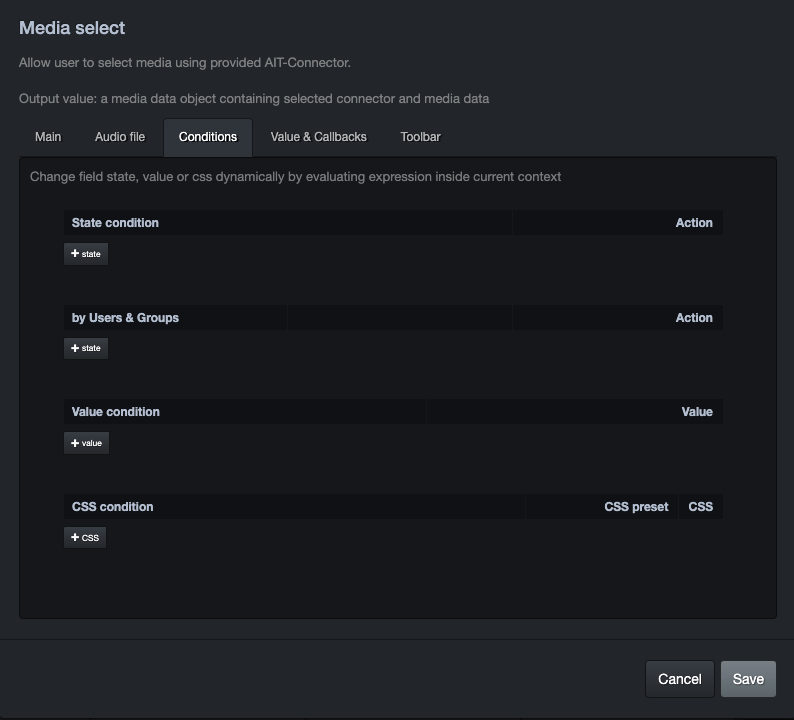
Evaluations are always done inside the field context, and gives you access to all fields sharing the same parent than the field being evaluated
Depending of field type, you have access to some special states or css conditions
Exemple: You want to show/hide a choice based on a checkbox object value.
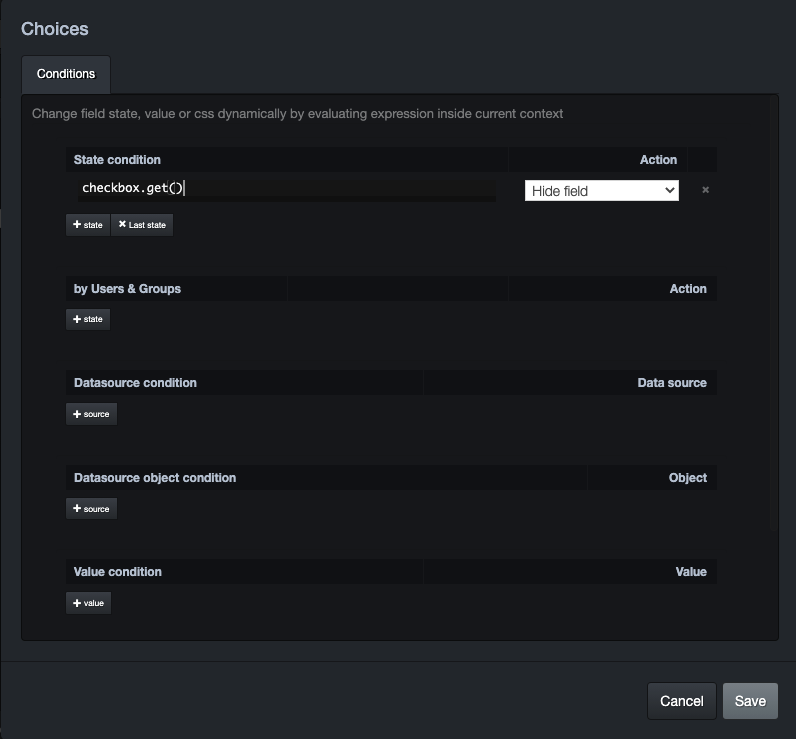
Conditional State
This will change the state of the form object based on the condition.
All fields have a set of commons conditional states: - Show - Hide - Enable - Disable - Mandatory - Optional
Choices field have some additional states: - Show option - Hide option - Enable option - Disable option
Table list have some additional states: - Show row - Hide row - Enable row - Disable row
Table column additional states: - Show column - Hide column
Conditional value
This will Change current field value if condition is true.
Conditional CSS
This will change the CSS applied based on the condition.
All fields : Add a specific custom CSS or CSS preset if condition is true.
Table list: Add a specific custom row CSS or CSS preset if condition is true.
Conditional Users and Group
This will change the form object state based on your login user and groups
Conditional Datasource
Change the datasource used to populate a choice if condition is true.
Field context during condition evaluation
Each evaluation of a field callback or condition is done inside a special context, giving you access to any fields editor and value.
Depending of the field placement inside the form hierarchy, context will contain a reference to "me" and all his "brothers":
me
This is the special keyword representing current field editor. You can read its value with me.get(), and change it with me.set(new_value)
brothers
This is all the other fields sharing the same parent as "me". If me is inside a grouped fields, brothers are the fields directly inside the group If me is inside a Table list, brothers are the field inside the same row as me
input_context
This object contains all the data generated by your form. It could be more practical to get a field value through input_context than its editor.
find_editor(path)
This is the function you can use to find a specific editor inside the whole form, and from any field evaluation It could be useful when the editor you want to access is not a direct brother of the field being evaluated.
Path parameter is a string representing the hierarchy of the field you want to find.

You can easily obtain a field path by clicking the Copy field path path button of the field toolbar.
In this example, to find the Choices B editor from any evaluation, click its Copy field path button. It will be copied to clipboard, and usable like this:

Note that Choices A is directly accessible under his field key from each of his brothers.
In this example, to change Choices B value from Choices A, it will be simpler to do:

Debugging field evaluation
Sometimes, it could be useful to stop execution of a specific field evaluation, and have access to all the context informations. It could be achieve with the special keyword debugger, included in all modern browsers, and usable like this:

Before seeing any effect of the debugger keyword, you will have to open the browser inspector (see your browser documentation for more details)
Once the Inspector opened, execution will stop when debugger keyword reached, and Inspector will be positioned inside your code, depending of the evaluation you are debugging (callback init, change, condition, …)

Note that you can use Inspector console to consult any data included in the Field context (data included inside With block of the right panel)